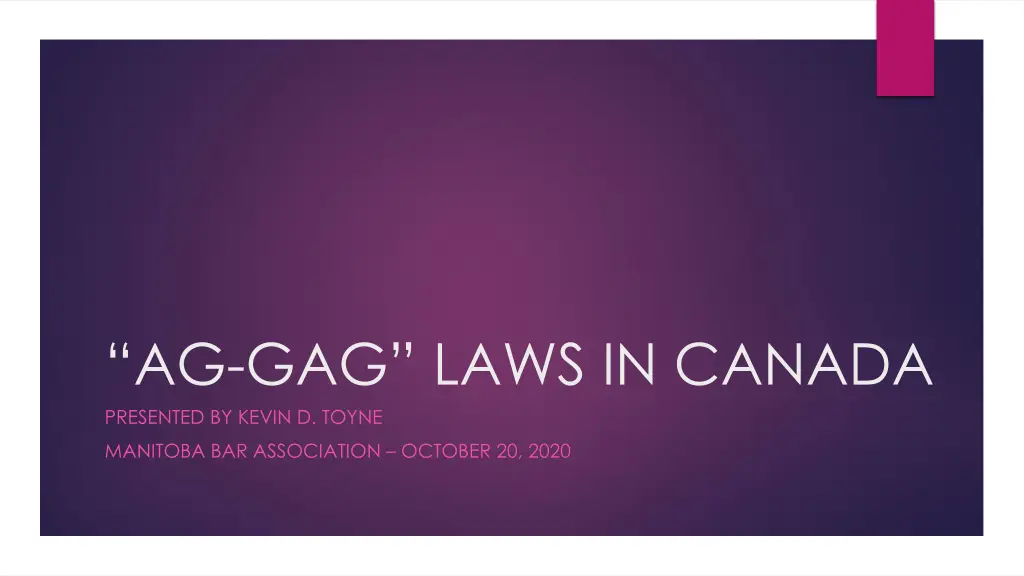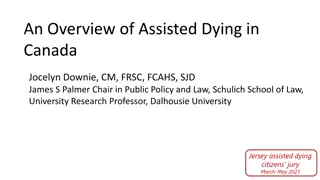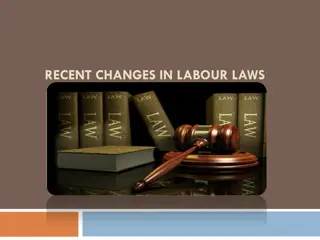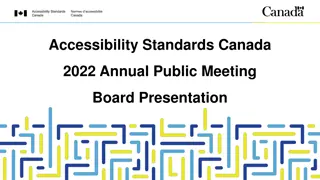
Understanding Ag-Gag Laws: Impacts on Agriculture and Freedom of Speech
Dive into the world of Ag-Gag laws in Canada and the United States, exploring their origins, purpose, legal challenges, and real-world effects on agricultural facilities. Learn how these laws impact investigative reporting and challenge freedom of speech in the agricultural industry.
Download Presentation

Please find below an Image/Link to download the presentation.
The content on the website is provided AS IS for your information and personal use only. It may not be sold, licensed, or shared on other websites without obtaining consent from the author. If you encounter any issues during the download, it is possible that the publisher has removed the file from their server.
You are allowed to download the files provided on this website for personal or commercial use, subject to the condition that they are used lawfully. All files are the property of their respective owners.
The content on the website is provided AS IS for your information and personal use only. It may not be sold, licensed, or shared on other websites without obtaining consent from the author.
E N D
Presentation Transcript
AG-GAG LAWS IN CANADA PRESENTED BY KEVIN D. TOYNE MANITOBA BAR ASSOCIATION OCTOBER 20, 2020
AG-GAG LAWS IN CANADA What is Ag-Gag ? Purpose Theory v. Reality Effect Legal Challenges to American Ag-Gag American Influence on Canadian Ag-Gag Alberta and Ontario Manitoba
What is Ag-Gag? Animal Legal Defense Fund et al v. Hebert et al (U.S.D.C. Utah, 2017) Judge Shelby: For as long as farmers have put food on American tables, the government has endeavored to support and protect the agricultural industry. In an address to Congress shortly after the Revolutionary War, George Washington, an ardent tobacco farmer, declared that agriculture is of primary importance, and argued that the rapid growth of the young nation rendered the cultivation of the soil more and more an object of public patronage. In short, governmental protection of the American agricultural industry is not new, and has taken a variety of forms over the last two hundred years.
What is new, however, is the recent spate of state laws that have assumed an altogether novel approach: restricting speech related to agricultural operations. These so-called ag-gag laws have their genesis in the 1990s. Around that time, animal rights advocates had begun conducting undercover investigations to expose animal abuse at various facilities. After these initial investigations became public, Kansas, Montana, and North Dakota all enacted ag-gag laws. The laws criminalized entering an animal facility and filming without consent.
Nobody was ever charged under these laws, and for nearly two decades no new ag-gag legislation was introduced. That changed, however, after a series of high profile undercover investigations were made public in the mid to late 2000s. The publication of these and other undercover videos had devastating consequences for the agricultural facilities involved. The videos led to boycotts of facilities by McDonald s, Target, Sam s Club, and others. They led to bankruptcy and closure of facilities and criminal charges against employees and owners. They led to statewide ballot initiatives banning certain farming practices. And they led to the largest meat recall in United States history, a facility s entire two years worth of production. Over the next three years, sixteen states introduced ag-gag legislation.
Purpose of Ag-Gag - Theory Animal Legal Defence Fund et al v. Reynolds et al (U.S.D.C. Iowa, 2019) Senior Judge Gritzner: Lawmakers described the bill as being responsive to two primary concerns of the agricultural industry: facility security (both in terms of biosecurity and security of private property) and investigative reporting. harms that accompany
Purpose of Ag-Gag - Reality Animal Legal Defense Fund et al v. Otter et al (U.S.D.C. Idaho, 2015) Chief Judge Winmill: to limit and punish those who speak out on topics relating to the agricultural industry, striking at the heart of important First Amendment values. to silence animal activists and to protect agricultural facility owners by, in effect, suppressing speech critical of animal-agriculture practices
Effect of Ag-Gag Otter: The effect of the statute will be to suppress speech by undercover investigators and whistleblowers concerning topics of great public importance: the safety of the public food supply, the safety of agricultural workers, the treatment and health of farm animals, and the impact of business activities on the environment.
Otter: Nonetheless, the State would have the property and privacy interests of agricultural production facilities supersede all other interests. But food production is a heavily regulated industry. And agricultural production facilities already must suffer numerous intrusions on their privacy and property because of the extensive regulations that govern food production and the treatment of animals. Given the public s interest in the safety of the food supply, worker safety, and the humane treatment of animals, it would contravene strong First Amendment values to say the State has a compelling interest in affording these heavily regulated facilities extra protection from public scrutiny.
Awareness of ag-gag laws erodes trust in farmers and increases support for animal welfare regulations , Food Policy 61 (2016) 121 125 Abstract: We found that most people were unaware of ag-gag laws and that learning about them lead to a decrease in trust in farmers and an increase in support for animal welfare regulations. Interestingly, we also found evidence that awareness of ag-gag laws negatively impacted perceptions of the current status of animal welfare as well as the perception that farmers do a good job of protecting the environment.
Legal Challenges Idaho U.S. District Court for the District of Idaho, 2015: I.C. 18-7042 (a) (d) are unconstitutional. Utah U.S. District Court for the District of Utah (Central Division), 2017: U.C. 76-6- 112 is unconstitutional. Iowa U.S. District Court for the Southern District of Iowa (Central Division), 2019: Iowa Code 717A-3A is unconstitutional. U.S. Court of Appeals (9th Circuit), 2018: I.C. 18-7042 (a) and unconstitutional, but (b) and (c) are constitutional. U.S. Court of Appeal (8th Circuit): Appeal pending. (d) and
Legal Challenges Iowa, Part 2 March, agricultural facility trespassing law is enacted by I.C. 717A-3B. December, 2019: Senior Judge Gritzner injunction enforcement of I.C. 717A- 3B pending disposition of constitutional challenge. Arkansas U.S. Eastern Arkansas, Challenge of A.C. 16-118- 13 dismissed. Kansas U.S. District Court for the District of Kansas, 2020: K.S.A. 47-1827 (b), (c) and (d) are unconstitutional, 47-1827 (a) and 47-1828 are constitutional. 2019: New District Court District for of production 2020: grants U.S. Court of Appeals (8th Circuit), 2020: Appeal pending. prohibiting
Influencing Canadian Ag-Gag Different constitutional systems Different powers of federal and provincial governments Focus on trespass and occupier liability Bill of Rights v. Charter of Rights and Freedoms Avoid impacts on exercise of freedom of speech and assembly Access zone precedents Focus on protecting the physical and emotional well-being of owners and occupiers of premises with farmed animals and their agents
Alberta Trespass Statutes (Protecting Law- Abiding Property Owners) Amendment Act, 2019 The Trespass Statutes (Protecting Law-Abiding Property Owners) Amendment Act, 2019 amended five provincial statutes: Limitations Act; Occupiers Liability Act; Petty Trespass Act; Provincial Offences Procedure Act; and Trespass to Premises Act.
Adopts criminaltrespasser concept and relaxes an occupiers duty of care towards them Consent for purposes of trespass no longer effective if obtained by falsepretences Offence for corporations and their directors, officers and agents to aid, counsel or direct persons to trespass Entry prohibited without notice on land used for raising and maintenance of animals Increased amount of restitution that can be ordered from $25,000 to $100,000 Increased penalties for trespassing and substantial penalties for corporations that aid, counsel or direct trespassing
Albertas Critical Infrastructure Defence Act 1(1) In this Act, (a) essentialinfrastructure means any of the following: (vi) an agricultural operation as defined in the Agricultural Operation Practices Act;
Agricultural Operation Practices Act (b) agriculturaloperation means an agricultural activity conducted on agricultural land for gain or reward or in the hope or expectation of gain or reward, and includes (ii) the raising of livestock, including diversified livestock animals within the meaning of the Livestock Industry Diversification Act and poultry, (iii) the raising of fur-bearing animals, pheasants or fish, (vi) the production of eggs and milk,
Prohibitions 2(1) No person shall, without lawful right, justification or excuse, wilfully enter on any essential infrastructure. (2) No person shall, without lawful right, justification or excuse, wilfully damage or destroy any essential infrastructure. (3) No person shall, without lawful right, justification or excuse, wilfully obstruct, interrupt or interfere with the construction, maintenance, use or operation of any essential infrastructure in a manner that renders the essential infrastructure dangerous, useless, inoperative or ineffective. (4) No person shall aid, counsel or direct another person to commit an offence under subsection (1), (2) or (3), whether or not the other person actually commits the offence. (5) A person who enters on any essential infrastructure, having obtained by false pretences permission to enter on the essential infrastructure from the owner or an authorized representative of the owner, is deemed to have contravened subsection (1) unless the person had a lawful right, justification or excuse to enter on the essential infrastructure.
R. v. Spratt, 2008 BCCA 340 Two male protestors were convicted of offences under British Columbia sAccess to Abortion Services Act for protesting within the Everywoman s Health Clinic accesszone . The legislation was passed following several years of aggressive protest activity that followed the Supreme Court sMorgentaler decision and increasing anti-abortion violence in Canada and the USA. The Crown conceded that the statute violated section 2(b) of the Charter and the case focuses on whether or not the impugned provisions can be justified under section 1.
[91] constitutionally protected right. The object of the Act is to protect vulnerable women and those who provide for their care to have safe, unimpeded access to health care services. The question is whether the degree to which the Act limits the right of those to demonstrate their opposition to abortion and to seek to persuade women to decide disproportionate to the purpose of the Act. The purpose or objective of the Act is sufficiently important to justify a limitation on the way in which freedom of expression is exercised in an area adjacent to the facilities providing abortion services. The impugned provisions of the Act are crafted in such a way that the deleterious effects do not outstrip the importance of the objective of the legislation. The objective of the Act justifies the limited infringement of freedom circumstances. [emphasis added] The right to express opposition to abortion is a against abortion is of expression in the
Ontario Security from Trespass and Protecting Food Safety Act, 2020 No person shall enter in or on an animal protection zone on a farm or animal processing facility without the prior consent of the owner or occupier of the farm or animal processing facility. No person shall interfere or interact with a farm animal in or on an animal protection zone on a farm, animal processing facility or prescribed premises, or carry out a prescribed activity in or on the animal protection zone, without the prior consent of the owner or occupier of the farm, facility or premises.
animal protection zone, with respect to a farm, animal processing facility or prescribed premises, means an area on the farm, facility or premises on which farm animals may be kept or located and that is, (a) an enclosure for farm animals, whether or not it is marked as an animal protection zone, (b) an area that meets prescribed requirements and is marked as an animal protection zone by the owner or occupier using signs in accordance with the regulations, or (c) an area prescribed by the regulations as an animal protection zone for the purposes of this Act; No person shall stop, hinder, obstruct or otherwise interfere with a motor vehicle transporting farm animals.
Purposes 1 The purposes of this Act are to prohibit trespassing on farms and other properties on which farm animals are located and to prohibit other interferences with farm animals in order to, (a) eliminate or reduce the unique risks that are created when individuals trespass on those properties or interfere with farm animals, including the risk of exposing farm animals to disease and stress as well as the risk of introducing contaminants into the food supply; (b) protect farm animals and the food supply chain from the risks described in clause (a); (c) protect the safety of farmers, their families and persons working in or on farms, animal processing facilities and prescribed premises as well as the safety of drivers of motor vehicles transporting farm animals; and (d) prevent any adverse effects the risks described in clause (a) may have on Ontario s overall economy.
Consent obtained through duress or false pretences is insufficient. Trespassers in APZs are required to provide identifying information upon request by the owner or occupier. Owners and occupiers are provided with powers of arrest without warrant. Owners of vehicles that are used to commit an offence are jointly and severally liable for fines imposed on a driver convicted of an offence. Fines up to $15,000 (first offence) and $25,000 thereafter unless increasedpenalties are required due to increased gravity of offence in accordance . Restitution for damages, including loss of animals. Recovery of costs of private prosecution permitted. Reduced occupier duties to trespassers in APZs. Limited liability for drivers of vehicles transporting animals.
Proclamation and Proposed Regulation On June 19, 2020, an animal rights activist named Regan Russell was run over by a farm animal transport truck outside of a slaughterhouse in Burlington. In response, those provisions of the Act prohibiting interference with motor vehicles transporting farm animals were proclaimed as of September 2, 2020. Proclamation of the remainder of the Act awaits the development of the regulation and a consultation process concerning the content of that regulation has just ended.
Highlights of the discussion paper include: Limitations on the ability of owner/occupier to designate entire premises as APZ and a requirement that an APZ not extend beyond the boundaries of the premises of the owner/occupier. Potential exemptions for journalists and whistleblowers with a definition of journalist similar to that found in the federal Journalistic Sources Protection Act, 2017: a person whose main occupation is to contribute directly, either regularly or occasionally, for consideration, to the collection, writing or production of information for dissemination by the media, or anyone who assists such a person
Proposed definitions: journalist means a person whose main occupation is to contribute directly, either regularly consideration, to the collection, writing or production of information for dissemination by the media and gained entry to an animal protection zone or the motor vehicle transporting farm animals with a bona fide journalistic purpose or occasionally, for mainoccupation would be defined as primary means of earning a living
Section 23(i) of the Act allows for the principles governing the increase in penalties to be set out in regulation. One of the aggravating factors being considered is whether any humanharm occurred. Human harm may be defined to mean physical injury, emotional injury, undue stress, psychological injury, financial injury or death, including any combination thereof
Manitoba Rural Crime and Bio- Security The provincial government intends to introduce legislation that will amend three provincial statutes: Occupiers Liability Act; Petty Trespasses Act; and Animal Diseases Act. Consultation website suggests significant weakening of occupier liability by introducing minimum duties for trespassers and potentially criminal trespassers. Consultation website also suggests introduction of biosecurityareas or animal protection areas .
On December 6, 2018, Minister of Justice Cliff Cullen made the following comments in the House while speaking in opposition to the Official Opposition s proposed Safe Access to Abortion Services Act: Our view is protecting freedom of expression cannot be an ideological issue, and that is not, quite frankly, how our Constitution works. Madam Speaker, doing away with people s freedoms is something we should be very, very careful not to do. On various issues there are oftentimes many different opinions and many different points of view abound. You cannot take away someone s freedom of speech just because you don t agree with them. Many people before us have fought hard for the freedoms that Manitobans now enjoy. These freedoms are precious and those freedoms should be safeguarded. Madam Speaker, we will stand up for the freedom of expression for Manitobans, regardless of whether or not we agree with them.
Throne Speech October 7, 2020 As Canadians, we are rightly proud of our democratic institutions and processes, built upon a foundational respect for the rule of law. Legal protest has helped shape our democracy and must be protected and cherished. Earlier this year, however, Manitoba experienced the negative economic effects of illegal protests and blockades, putting the livelihoods of people and communities at risk. Your government will introduce legislation to prevent such illegal blockades of critical transportation routes and protect jobs.
Section 57 of the QB Act No injunction re freedom of speech 57(1) Subject to subsection (3), the court shall not grant an injunction that restrains a person from exercising the right to freedom of speech. "Exercise right to freedom of speech" 57(2) For the purposes of this section, the communication by a person on a public thoroughfare of information by true statements, either orally or through printed material or through any other means, is an exercise of the right to freedom of speech.
Exceptions 57(3) (a) enforcement by criminal or quasi criminal proceedings of an Act of Parliament or of the Legislature or of a by-law of a municipality respecting (i) the use of public thoroughfares, (ii) the protection of public property, (iii) the general conduct of persons in public places, or (iv) restrictions on or prohibitions against the making of certain statements or statements of certain types; or (b) enforcement by a civil proceeding (i) of an Act of Parliament or of the Legislature respecting restrictions on or prohibitions against certain statements or statements of certain types, or (ii) of the law respecting defamation. Nothing in this section affects
"Public thoroughfare" 57(4) In this section, "public thoroughfare" includes a walk, driveway, roadway, square and parking area provided outdoors at the site of and in conjunction with a business or undertaking and to which the public is usually admitted without fee or charge and whether or not the walk, driveway, roadway, square or parking area is owned by the person carrying on the business or undertaking or is publicly owned.
AG-GAG LAWS IN CANADA Presented by Kevin D. Toyne Manitoba Bar Association October 20, 2020






















